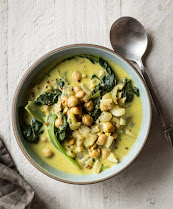Cooking With This Week's Box
.jpg) |
| Photo from www.williams-sonoma.com |
Vegetable Feature: Brussels Sprouts
To prepare sprouts for a recipe, use a paring knife to trim
a little bit off the base of each sprout which will allow a few outer leaves to
fall off. If the sprouts are small, you may cook them whole. If they are a little
larger you may want to cut them into halves or quarters. I should mention that
Brussels sprouts may also be eaten raw in slaws and salads. In their raw form
they are generally sliced very finely. Brussels
sprouts are a natural pairing with other vegetables including garlic, onions
(especially caramelized onions), winter squash, root vegetables, sweet potatoes,
and mushrooms. They also pair well with fall fruits including apples,
cranberries, pomegranate, and lemons. In my kitchen, they also have an attraction
to butter! Additionally, they pair well with other dairy products including
Parmesan, feta, and blue cheese as well as cream. Their strong flavor goes well
with salty, cured meats such as bacon and sausage as well as toasted nuts. A
drizzle of maple syrup, honey or even balsamic vinegar is also a nice way to
finish off a Brussels sprouts recipe.
Store Brussels sprouts in the refrigerator in the plastic
bag we’ve portioned them in for you.
They will keep for several weeks, but we recommend you eat them within a
week or two. We are grateful to share the bounty of this year’s harvest with
you and hope you enjoy them!
Shredded Brussels Sprouts and Bacon Pizza
.jpg) |
| Photo from halfbakedharvest.com |
- Preheat the oven to 450°F. Grease a large baking sheet or pizza pan with olive oil.
- In a small bowl, combine 1 Tbsp olive oil, the honey, balsamic vinegar, shallot, garlic, thyme, and a pinch each of red pepper flakes, salt, and pepper.
- In a separate bowl, toss together the remaining 1 Tbsp olive oil, the Brussels sprouts, Parmesan or Manchego, and a pinch of salt and pepper.
- On a lightly floured surface, push/roll the dough out until it is pretty thin (about a 10-12 inch circle). Transfer the dough to the prepared baking sheet.
- Spread the dough with the olive oil/balsamic herb mix. Add the fontina or Havarti cheese, then layer the Brussels sprouts over the cheese. Bake for 10-15 minutes or until the crust is golden and the cheese has melted.
- Meanwhile, cook the bacon until crisp. Top the pizza with the crispy bacon and additional freshly shaved Parmesan. Slice and enjoy!

.jpg)
.jpg)



.jpg)
.jpg)
.jpg)
.JPG)


.jpg)
.jpg)


.jpg)

.jpg)
.jpg)
.jpg)



.jpg)
.jpg)